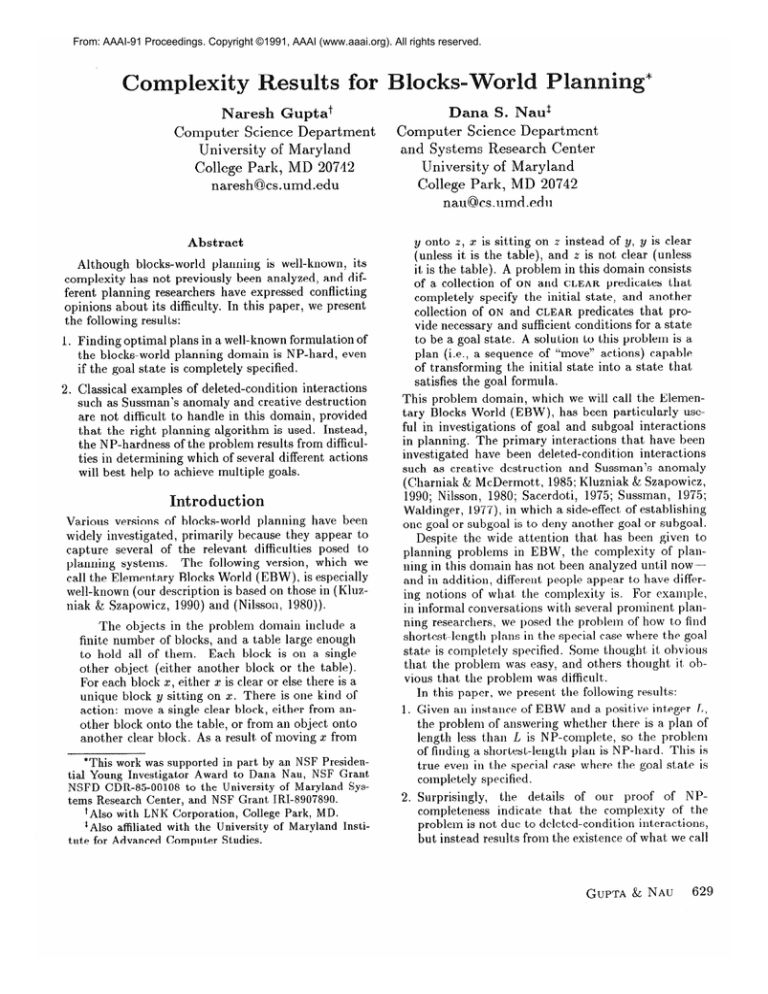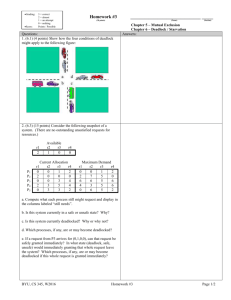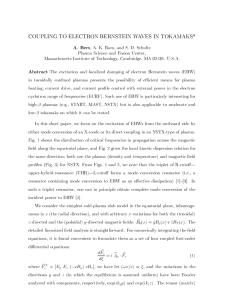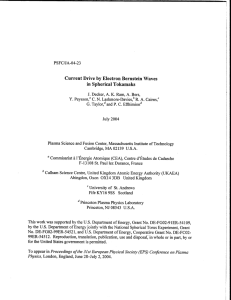
From: AAAI-91 Proceedings. Copyright ©1991, AAAI (www.aaai.org). All rights reserved.
exit
Naresh Guptat
Computer Science Department
University of Maryland
College Park, MD 20742
naresh@cs.umd.edu
Abstract
Although blocks-world
planning is well-known, its
complexity has not previously been analyzed, and different planning researchers have expressed conflicting
opinions about its difficulty. In this paper, we present
the following results:
1. Finding optimal plans in a well-known formulation of
the blocks-world planning domain is NP-hard, even
if the goal state is completely specified.
2. Classical examples of deleted-condition
interactions
such as Sussman’s anomaly and creative destruction
are not difficult to handle in this domain, provided
that the right planning algorithm is used. Instead,
the NP-hardness of the problem results from difficulties in determining which of several different actions
will best help to achieve multiple goals.
Introduction
Va.rious versions of blocks-world planning have been
widely investigated,
primarily because they a.ppear to
capture several of the relevant difficulties posed to
The following version, which we
planning systems.
call the Elementary Blocks World (EBW),
is especially
well-known (our description is based on those in (Kluzniak & Szapowicz, 1990) and (Nilsson, 1980)).
The objects in the problem domain include a
finite number of blocks, and a table large enough
Each block is on a. single
to hold all of them.
other object (either another block or the table).
For each block z, either x is clear or else there is a
unique block y sitting on X. There is one kind of
a,ction: move a single clear block, either from another block onto the table, or from an object onto
another clear block. As a result’ of moving x from
*This work was supported in part by an NSF Presidential Young Investigator
Award to Dana Nau, NSF Grant,
NSFD CDR-85-00108
to the University of Maryland Systems Research Center, and NSF Grant IRI-8907890.
‘Also with LNK Corporation,
College Park, MD.
1 Also affiliated with the University of Maryland Institute for Advanced Computer
Studies.
s-
- -
*
--
Dana S. Nad
Computer Science Department
and Systems Research Center
University of Maryland
College Park, MD 20742
nau@cs.umd.edu
y onto Z, x is sitting on z instead of y, y is clear
(unless it is the table), and z is not clear (unless
it, is the table). A problem in this domain consists
of a collection of ON and CLEAR predicates that
completely specify the initial state, and another
collection of ON and CLEAR predicates that provide necessary and sufficient conditions for a state
to be a goal state. A solution to this problem is a
plan (i.e., a sequence of “move” actions) capable
of transforming
the initial state into a state that
satisfies the goal formula.
This problem domain, which we will call the Elementary Blocks World (EBW),
has been particularly
useful in investigations
of goal and subgoal interactions
in planning. The primary interactions that have been
investigated
have been deleted-condit,ion
interactions
such as crea.tive destruction
and Sussman’s anomaly
(Charniak & McDermot,t, 1985; Kluzniak & Szapowicz,
1990; Nilsson, 1980; Sacerdoti,
1975; Sussman,
1975;
Waldinger, 1977), in which a side-effect, of establishing
one goal or subgoal is t,o deny another goal or subgoa.1.
Despite the wide attention that, has been given to
planning problems in EBW, the complexity of planning in this domain has not been analyzed until now -and in addition, different people appear t(o have differing notions of wl1a.t the complexity is. For example,
in informal conversations with several prominent planning researchers, we posed the problem of how to find
shorttest-length plans in the special case where the goa.
state is complet,ely specified. Some thought it obvious
that the problem was easy, and others t8hought it, ohvious tha.t the problem was difficult.
In this pa.per, we present, the following results:
Given an inst,ance of EBW and a posit(ive integer L,
the problem of answering whether there is a plan of
length less t,han L is NP-complete,
so the problem
of finding a shortest-length
plan is NP-hard. This is
true even in t,he special case where t,he goal state is
completely specified.
the details
of our proof of NPSurprisingly,
completeness
indicate t,hat the complexity
of t,he
problem is not due to deleted-condition
int,eractions,
but instead results from the existence of what, we call
GUPTA & NAU
629
“deadlock” situations, in which some critical step is
needed to facilitate the achievement of several different goals. Some steps are capable of resolving more
than one deadlock at once-and
what is difficult is to
find a set of critical steps that resolves all deadlocks
and is as small as possible. All remaining steps in the
plan can be determined easily, regardless of whether
or not they would correspond to deleted-condition
interactions in the traditional sense.
Definitions
and Notation
In this paper, we use the usual definitions of the ON and
CLEAR predicates and the MOVE operator. As usual, a
plan is a totally ordered set of actions, each of which
can be applied to the state that results from the actions
that precede it. If P is a plan, then length(p)
is the
number of actions in P.
The EBW optimization problem is as follows:
Given an EBW problem
shortest possible length.
B, find a plan for B of
Note that in B, every state s consists of a set of
stacks of blocks. We say that a block b in s is in ifs
final position if there is a state g satisfying the goal
formula such that all blocks below b in s are also below
b in g, in exactly the same order.
We say that the set of blocks { bl, ba, . . . , bp} in s is
deadlocked if there is a set of blocks { dr , da, . . . , dp}
such that the following two conditions hold:
1. in the state s, bl is above dl, b2 is above da, . . ., and
bp is above dp;
2. in the goal state,
b, is above dl.
bl is above da, b2 is a.bove d3, . . .,
For example, in Fig. 1, t$he initial state
deadlocked sets of blocks:
contains
two
1. a is above c and d is above e in the initial state, and
a is above e and d is above c in the goal state, so
{a, d} is deadlocked in the initial state;
2. a is above b in both the initial state and the goal
state, so {a} is deadlocked in the initial state.
Suppose S is a. deadlocked set and A is an applicable
action. Then we say that A resolves the deadlock if S
is no longer deadlocked after A is performed.
If one
of the blocks in S is clear, then moving it to the table
will always resolve the deadlock-and
it ma.y resolve
more than one deadlock simultaneously.
For example,
in Fig. 1, moving a to the table will resolve both the
deadlocked sets {a, d} and {a}.
Recall that in EBW, the initial state must be completely specified but the goal state need not be completely specified. Instead, it is possible for more than
one state to satisfy the goal formula.
We define the
Primitive Blocks World (PBW) to be the special case
of EBW in which the goal state is completely specified.
For use in proving NP-completeness
results about
PBW, we follow the standard procedure for converting
630
MATHEMATICAL
FOUNDATIONS OF PLANNING
lqpj Mlq
Initial state
Goal state
Figure 1: A blocks-world problem with two deadlocked
sets of blocks: {a, d} and {a}.
optimization
problems into yes/no decision problems.
The Yes/No PBW (YPBW)
decision problem is as follows:
Given a PBW problem B and an integer L > 0, is
there a plan for B of length less than L?
Algorithms
Let B be a PBW
observations:
problem.
We make the following
1. Whether or not each block b is in its final position
can be computed in low-order polynomial time, by
examining
the stack of blocks beneath b to see if
the adjacent blocks in this stack correspond to ON
predicates in the goal formula.
2. Any block already
moved.
in its final position
need not be
3. Any block not already in its final position must be
moved at least once. However, it does not need to
be moved more than twice: we can move it to the
table until its final position is clear, and then move
it to its final position.
4. If b is moved more than once in some plan P for B,
then there is a plan P’ for B in which b is moved
twice (once from its initial position to the table, and
later from the table to its final position),
and all
other actions are the same as in P.
5. From the above observations, it follows that if there
are n blocks in B, then the length of a shortestlength plan for B is between 0 and 2n.
The above observations
make it clear that for any
a plan P
PBW problem B, it is easy to generate
whose length is no more than twice the shortest possible lengt#h. Simply move to the table all blocks that
are not in their final positions, and then move these
blocks one by one into their fina* positions. This plan
can be generated in low-order polynomial time.
Finding a shortest-length
plan is more difficult-but
if we are allowed to use nondeterminism,
it can be
done in low-order polynomial tNime by the nondeterministic algorithm Solve-PBW
shown below. In this
algorithm, RESOLVE
is a nondeterministic
command
that resolves a deadlock among the top blocks of stacks
in the current state, by moving one of the blocks from
top of a stack to the table.
Algorithm Solve-PBW
Input: a PBW problem
B.
Output: a plan P for B.
Step 1: Current state t initial state.
Step 2: If the current state is the same as the goal
state, then EXIT.
Step 3: If there is a block b that can be moved to
its final position, move it and go to Step 2.
Step 4: If we reach this step, then the set of all
blocks that are at the tops of their stacks and
are not in their final positions form one or more
deadlocked sets. Call RESOLVE
to resolve one
of these deadlocks, and go to Step 2.
1x2
the graph G
B’s init al state
Theorem I Let B be any PB W problem with p blocks,
of which q blocks in the initial state are already in their
Then the length of a shortest-length
final positions.
plan for B is p-q-!-r,
where r is the minimum number
of times RESOLVE
is called in any of the execution
traces of nondeterministic
procedure Solve-PI3 W(B).
Proof.
Let P be any plan for B.
From Observation 4 it follows that there is a plan P’ with
such that for every block b
length( P’) 5 length(P)
that is moved more than once, b is moved exactly twice:
once from its initial position to the table and once from
the table to its final position.
Let s be the state just
before b is moved for the first time. For every block c
in s that can be moved directly to its final state, moving c to its final position before moving b to the table
cannot possibly interfere with any subsequent moves.
Thus, there is a plan P” with length(P”)
< length(P)
having the property that whenever a block is moved
to the table, the current state contains no block that
can be moved directly to its final sta.te. Solve-PBW
generates every plan having this property, so therefore
it generates a plan of shortest possible length.
But
the shortest-length
plan generated by Solve-PBW
has
length p - q + r, so this must be the shortest possible
length of any plan for B.
Complexity
Results
In this section, we show that YPBW is NP-completeand that therefore, the PBW and EBW optimiza.tion
problems are NP-hard.
Lemma 1 YPB W belongs to NP.
Proof.
algorithm
We give a nondeterministic
to solve YPBW:
polynomial
time
Algorithm Solve-YPBW
Input: a YPBW problem (B, L).
Output:
True if there is a plan for B of length
< L, and False otherwise.
Step 1: If Solve-PBW(B)
finds a plan P such that,
length(P)
< L, return True. Else return False.
Solve-YPBW
returns True if and only if (B, 6) belongs
to YPBW.
Since Solve-PBW
takes polynomial time,
Solve-YPBW
also takes polynomial time.
To show that YPBW
is NP-hard, we need to show
that an NP-complete problem reduces to YPBW.
For
B’s goal state
Figure
turned
2: A graph G, and the PBW
by M(G, k).
problem
this purpose we use the Feedback Arc Set (FAS)
sion problem, which can be stated as follows:
B re-
deci-
Given a digraph G = (V, E) and a positive integer
k, is there a set, of edges S of cardinality less than
k, such that the digraph G’ = (‘c’, E-S)
is acyclic?
This problem is known to be NP-complete
((Garey &
Johnson, 1979), p. 192).
If G = (V, E) is a digraph, then without loss of
genera.lity we may assume that C’ is the set of integers {1,2,.
. ., n} for some n. If (G, k) is a FAS problem, then we define M(G, k) to be the YPBW problem
(B, L), where L = (2n + 2)n + k, and B is the PBW
problem defined below:
o For each ‘/IE V, B’s initial state contains a stack of
2n + 3 blocks, named (from the bottom of the stack
to the top) [I), I, n+ 11, [‘/I,I, n], . . ., [v, I, 01, [v, O,O],
. . ., [v, 0, n] (see Fig.
2). Thus, B’s initial state
consists of ~2 stacks of 2n + 3 blocks each, for a total
of 2n” + 3n blocks.
e B’s goal state has [x:, 0, y] st’acked on [y, I, x] for
every edge (x, y) in E, and all other blocks sitting
on the ta.ble. Thus, B’s goal state contains 1El stacks
of 2 blocks each, and 2n.2 + 3n. - IEI blocks sitting
on the table by themselves.
M(G, k) can easily be computed in polynomial time.
For the rest of this section, we let (G, k) be any FAS
problem, aad (B, L) = M(G, k).
Lemma 2 Each
deadlocked
Proof.
Then
in E,
cycle in G corresponds
set in. B.
to a un.ique
Suppose G contains a cycle (~1, tjz, . . . , up, ~1).
the edges (IQ, ~12)~ (2’2, US), . . ., (up, VI) are
so in B’s goal state, we ha.ve [.ul, 0, ZQ] on
[9, I, VI], [Q, O,Q] on [US,I, VJ],. . ., and [up, 0,VI]
on[v,I,upI.But
in
B’s
initial
state,
GUPTA
we have
& NAU
631
[VI,0,w] above
[VI,I, vp],[~a, O,v3] above
[v2, I, VI],
...) and [up, 0, vi] above [up, I, up-i]. Thus the set
[We,0, VI]) is deadlocked.
Conversely, suppose a set of blocks D is deadlocked.
Then each block b E D must be on some other block
c in the goal state.
But from the definition of B,
this means there are v,w such that b = [v,O,w]
and c = [w, 0, w]. Thus, there are ~1, ~2,. . . , ~5, such
that D = ([%I, 0, 221, [Q,
a],
B’s goal state contains the following stacks: [Q, 0, ~21
{[Vl,
0, v2l,[v2,@
v31, * * . ,
0,
on
[~2,L.4,
[~2,0,~3]
on
...,[zp,
0,%I]}and
[z3, IJZ],
. . ., [+O,al
on
[zI, I, ~~1. From the definition of B, this means that
(a,
z2, * * . , +, ~1) is a cycle in G.
Thus each cycle in G corresponds to a0unique deadlocked set of blocks in B.
An example of Lemma 2 appears in Fig. 2, in which
the cycle (1,2,1)
in G corresponds to the deadlocked
set of blocks {[l, 0,2], [2,0,1]).
Lemma 3 B h-as a plan of length less than. L iflG has
a feedback
arc set of size less than k.
Proof.
(-)):
Suppose B has a plan P for which
length(P)
< L, and let S be the set of all blocks that
are-moved more than once in P. From Observation 4,
we may assume that each block in S is moved twice:
once to the table and once to its final position. Since
2n2 + 2n blocks in B’s initial state are not in their final
positions, they must be moved at least once.
Thus
ISI < L - 2n2 + 2n = k - 1. For each deadlocked
set 6, P resolves the deadlock by moving some block
b E D to the table. From the definition of deadlock,
b’s final position must be on top of some other block,
so b E S. From the proof of Lemma 2, b = [v, 0, w]
for some edge (v, w) in 6.
Thus, S contains blocks
such that every deadlocked
[v IO, Wll, * * -, [“j, 0, ql
set D contains at least one of these blocks. From the
proof of Lemma 2, it follows that every cycle in G
contains one of the edges (~11,WI), . . ., (uj, wj), so G
has a feedback arc set of size j 5 IS] < k - 1.
(+-):
Suppose G has a feedback
arc set S =
k, and sup{(%
Wl), * * f , (v~, We)} such that p <
pose we invoke Solve-PBW(B).
The initial state contains 2~2~+ 2n blocks that are not in their final positions,
so Step 3 of Solve-PBW
will be executed
27x2 + 2n times.
Each time Solve-PBW
enters Step
4, the set of all blocks b that are at the top of their
stacks and are not in their final positions form one
or more deadlocked sets. From Lemma 2, each such
deadlocked
set D corresponds
to a cycle in G, so
a*t least, one block [vi, 0, wi] E D corresponds to an
edge (vi, rrti) E S. But moving [vi, 0, wi] to the ta.ble will resolve the deadlock.
Thus, there is an execution trace for Solve-PBW(B)
in which all deadlocks are resolved by moving to the table blocks in
the set ([Q, 0, UJ~], . . . , [up, 0, q,]},
whence Step 4 is
executed at most p times.
Thus, one of the execution traces for Solve-PBW
finds a plan P of length
length(P)
5 2n2 + 2n + p < 2n2 + 2n + k = L.
632
MATHEMATICAL
FOUNDATIONS OFPLANNING
Theorem 2 YPBW
is NP-complete.
Proof.
Lemma 3 shows that M reduces FAS to
YPBW.
Since A4 runs in polynomial time, this means
that YPBW
is NP-hard.
But Lemma 1 shows that
YPBW is in NP. Thus, YPBW is NP-complete.
Theorem 3 The PBW
and EBW
optimization
prob-
lems are NP-hard.
Proof. If we can find a shortest-length
plan, then we
can immediately tell whether there is a plan of length
less than L. Thus from Theorem 2, the YPBW
optimization problem is NP-hard. Since PBW is a special
case of EBW, the EBW optimization
problem is also
NP-hard.
Discussion
The nondeterministic
algorithm
Solve-PBW
finds
shortest-length
plans, and it needs to make a nondeterministic choice only when a deadlock occurs. If there
were no deadlocks, then Solve-PBW
would be a deterministic algorithm operating in low-order polynomial
time. Thus, it is the deadlocks that are responsible for
the NP-completeness
of YPBW-so
we need to examine them more carefully.
It is important to note that deadlocks are not the
same as deleted-condition
interactions.
Rather, an action a that! resolves a dea,dlock is useful because it facilitates the achievement of several different goals at
once. Some actions are capable of resolving more than
one deadlock-and
in finding a shortest-length
plan,
the critical problem is to find a smallest possible set
of actions capable of resolving all existing deadlocks.
All actions other than these resolving actions can be
determined quite easily by Solve-PBW.
The primary reason why deleted-condition
interactions do not cause problems in Solve-PBW
is that it,
does not consider the ON predicates in isolation, but,
instead considers the partial order induced by them.
For example, if we want, to achieve ON(x, y), we should
make sure that y is in its final position before we try
to move x to y. By “final position”, we do not mean
merely whether y is on the same block it will be on in
the goal state, buta whether the entire stack of blocks
below y is the same as it will be in the goal state.
It is straightforward
to generalize Solve-PBW
to
solve problems in EBW, and we intend to include a.
proof of this in (Gupta XL Nau, 1991). In EBW there
is not necessarily a. unique goal state-but
by doing a
topological sort on the ON predicates in the goal formula, we can easily deduce whether any block that is
currently below y in the current state will need to be
elsewhere in the goal state.
Conclusion
In this paper, we have discussed a well-known class
of planning problems which we call the Elementary
Blocks World (EBW). We have shown that the problem
of finding shortest-length
plans in EBW is NP-hard,
even if the goal state is completely specified. This result is interesting for two reasons. First is that in the
case where the goal state is completely specified, different planning researchers have had conflicting intuitions
about the difficulty of finding shortest-length
plansand this result answers the question. Second, the nature of the proof says something unexpected about why
blocks-world planning is difficult.
One of the primary uses of the blocks world in the
planning literature has been to provide examples of
deleted-condition
interactions such as creative destruction and Sussman’s anomaly (Charniak & McDermott,
1985; Kluzniak
& Szapowicz,
1990; Nilsson,
1980;
Sacerdoti,
1975; Sussman, 1975; Waldinger, 1977), in
which the plan for achieving - one goal
or subgoal interferes with another goal or subgoal. However, as we
present no
pointed out in Section , such interactions
problem if an appropriate planning algorithm is used.
The complexity of planning in EBW is due instead
to “deadlock” situations, in which some critical action
must be chosen in order to help in achieving the remaining goals. In choosing which action to use to resolve a deadlock, some actions are better than others,
because they will resolve more than one deadlock-but
if we use the hill-climbing approach of always choosing
the action that resolves the most deadlocks, this will
plan. Instead, we
not always result in a shortest-length
set of actions that remust find a minimum-cardinality
solves all deadlocks. UApparently this problem is what
causes planning in EBW to be NP-hard-for
if we can
solve this problem, it is easy to plan the other actions.
Nilsson, N. J. 1980. Principles
gence. Tioga, Palo Alto.
of Artificial
Intelli-
Sacerdoti, E. D. 1990. The nonlinear nature of plans.
In Allen, J.; Hendler, J.; and Tate, A., editors 1990,
Readings in Planning. Morgan Kaufman.
206-214.
Originally appeared in Proc. IJCAI- 75.
Sussman, G. J. 1975. A Computational
Model of Skill
Acquisition. American Elsevier, New York.
Waldinger, R. 1990. Achieving several goals simultaneously. In Allen, J.; Hendler, J.; and Tate, A., editors
1990, Readings in Planning. Morgan Kaufman.
118.
Originally appea,red in Machin.e Intelligence
8, 1977.
Acknowledgements
We wish to thank James Hendler for his many helpful
comments and discussions.
References
Allen, J.; Hendler, J.; and Tate, A., editors 1990.
Morgan-Kaufmann,
San Ma.Readings in PlanGng.
teo, CA.
Chapman,
D. 1987. Planning for conjunctive
Art$cial
Intelligen.ce 32:333-378.
goals.
Charniak,
E. and McDeimott,
D. 1985. Introduction
Addison-Wesley,
Rea.ding,
to Artificial Intelligence.
MA.
Garey, Michael R. and Johnson, D. S. 1979. C017~puters and Intractability A Guide to th.e Th.eory of NPCompleteness.
W. H. Freeman and Company Puhlishing.
Gupta, N. and Nau, D. S. 1991. On the complexity
of blocks world planning. Forthcoming.
Kluzniak,
and Szapowicz,
1990.
extract from apic
studies in data, processing
no. 24.
In Allen, J.;
Hendler, J.;and Tate, A., editors 1990, Readings in
Planning. Morga.n Kaufman.
140-153.
GUPTA
& NAU
633







